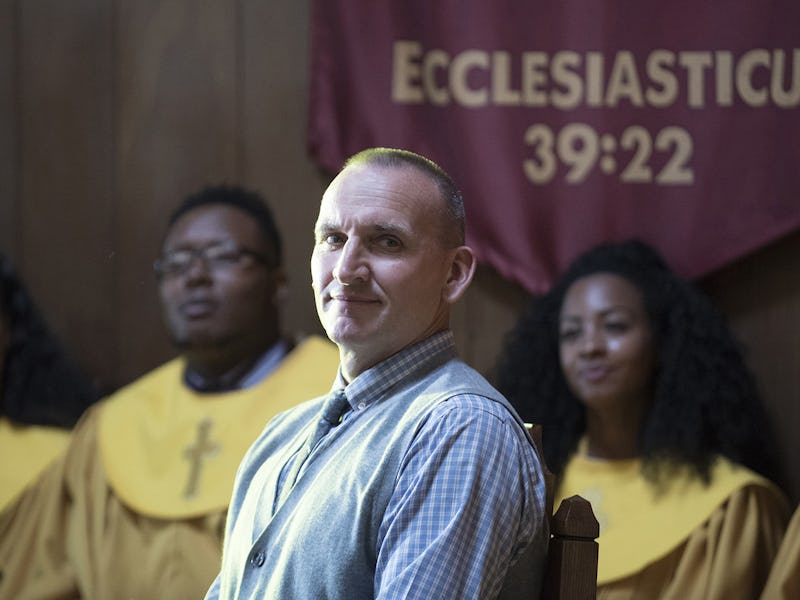Getting Weird With 'The Leftovers:' Episode 2.5, "No Room at the Inn"
Christopher Eccleston kills it in this Matt-centric episode

As The Leftovers returns with its second season, we break down what’s weird, what’s mysterious, and what’s simply The Fuck? on this intriguing, frequently puzzling, never dull show. Without further ado, let’s dive into the fifth episode, “No Room at the Inn.”
What’s confounding:
Matt’s decision to leave the town and take up residence on the pillory. His calm showdown with John Murphy was oddly badass — a word you wouldn’t normally associate with Matt Jamison — and satisfying, but what exactly is he hoping to accomplish? Part of what makes The Leftovers alarmingly great at characterization is that everyone behaves in surprising ways that keep you on your toes, but it’s consistent with their personalities. It feels inevitable once you consider it; it doesn’t feel like the writers are manipulating them for the sake of the plot. Matt’s behavior never seems to fit a given situation: he’s too compassionate at the wrong moments (guilelessly flaunting the fact that he lives in Miracle to the clearly desperate man on the side of the road) and finds his spine during times he should hide it (standing up to John Murphy). At the end of the episode, it’s unclear whether Matt’s decision to leave town is a triumph or yet another “Goddamnit, Matt!” moment. But either way, Christopher Eccleston kills it, deftly navigating the balance between making us feel for him (his heartbreaking care for Mary that resonates in every gesture; his childish naivete) and making us say, “Goddamnit, Matt!”
What’s Intriguing:
The question of whether Mary actually woke up and consented to their sexual encounter — and the show’s clear disinterest in answering it. The Leftovers loves posing questions whose answers ultimately don’t matter, because what matters is how the characters interpret and respond to them. As many critics pointed out when they discussed “Off Ramp,” this enables The Leftovers to explore things like rape in a manner that’s much better than other shows. “No Room at the Inn” continues to wallow in that grey area by refusing to provide a definitive answer on Mary’s catatonic state. By the end of the episode, we still have no idea whether Matt is a delusional, sad, accidental rapist, or whether a miracle did occur, and yet there’s no question that we still sympathize with him. As Amy Schumer calls it, if it is rape, it’s “grape” — grey area rape — which is the kind that occurs most frequently in life, yet TV typically gives preference to more sensational black-and-white depictions. Don’t get me wrong, there are plenty of Ramsey Boltons in the world, but there are far more Matt Jamisons. But entertainment short changes us time and again.
Normally, when we say “let’s talk about rape on TV,” we say it with a tired sigh because it’s used so frequently and so terribly. But this makes it twice this season that rape has been used not as a plot device, a shortcut to characterization, or cheap ploy, but as a legitimate exploration of boundaries, consent, intimacy, and people’s endless capacity for self-deception. It challenges the audience’s capacity to examine a deeply uncomfortable subject in nuanced ways — in other words, The Leftovers treats its audience like goddamn adults.
WTFs to file away for later:
- The goats in the road at the scene of the accident. Seriously, what is it with this show and wildlife? Who is Brian? I have only the barest knowledge of biblical lore but there’s no Brian in the bible, right? Why did that guy want to be hit? What? There were about 100 WTFs in that three-minute scene. A brief note on full-frontal nudity: I praised this show for how it dealt with full-frontal nudity in “Off Ramp” because it fit that scene with Tom and Meg and it was equal opportunity between both genders — which pretty much never happens on TV. That being said, this show is on the verge of overplaying its “full-frontal” position. I applaud it for skewing more towards male than female, since that’s rare to the point of being unheard-of. And it did fit the scene. But at the same time, you don’t want to be in a place where you’re raising the question, how much dick is too much dick?
The Final Verdict:
One of the things that makes The Leftovers unique among the crowded dystopian genre is how detailed the world is; how real it feels.
For example, if you consider The Hunger Games, can you actually picture daily life in all the districts? The weird Jarden purgatory outside the gate is developed enough that it could easily be its own show. We only need to see it for a minute or two before we understand how this micro-society functions. The religious nuts, the stoners listening to terrible music, the sunbathers, the obnoxious man-bun hustler oozing oily charm — this is exactly how humans would respond in this situation. The key to creating a believable world is authenticity, and though we only see a sliver of that world in “No Room At The Inn,” it’s captivating and chilling because it feels so possible.